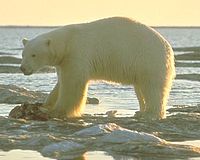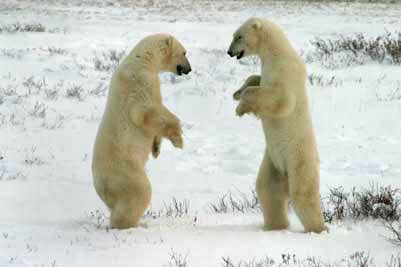| Revision as of 08:22, 19 March 2004 view sourcePcb21 (talk | contribs)Extended confirmed users20,408 edits move image up a notch← Previous edit | Revision as of 23:18, 4 April 2004 view source 195.50.12.117 (talk) Added spacing; I'm a bot, sorry if I messed anything upNext edit → | ||
| Line 1: | Line 1: | ||
| <table border="1" cellspacing="0" align="right" cellpading="2"> | <table border="1" cellspacing="0" align="right" cellpading="2" style="margin-left: 1em; margin-bottom: 0.5em;"> | ||
| <tr><th bgcolor=pink>Polar Bear<br>{{msg:StatusSecure}}</th></tr> | <tr><th bgcolor=pink>Polar Bear<br>{{msg:StatusSecure}}</th></tr> | ||
| <tr><td align="center">]</td></tr> | <tr><td align="center">]</td></tr> | ||
Revision as of 23:18, 4 April 2004
| Polar Bear Template:StatusSecure | ||||||||||||||
|---|---|---|---|---|---|---|---|---|---|---|---|---|---|---|
 | ||||||||||||||
| Scientific classification | ||||||||||||||
| ||||||||||||||
| Binomial name | ||||||||||||||
| Ursus maritimus Phipps, 1784 |
The Polar Bear (Thalarctos maritimus or Ursus maritimus) is a large mammal of the order Carnivora, family Ursidae. It is a circumpolar species found in and around the Arctic Ocean. It is the world's largest land carnivore. Adult males weigh from 400 to 600 kilograms and occasionally exceed 800 kilograms. Females are about half the size of male s and normally weigh 200 to 300 kilograms. Adult males measure 240 to 260 centimeters and females 190 to 210 centimeters. At birth, cubs weigh 600 to 700 grams.
The Polar Bear is instantly recognisable by its white coat. Unlike other arctic mammals it never sheds this coat for a darker colour in summer. The hair is not actually pigmented white; it is unpigmented and hollow, like white hair in humans.
An interesting feature of the coat is that it appears black when photographed with ultraviolet light. A number of people have suggested that this is because the hairs channel the light to the black skin of the bear to help it stay warm during the cold, sunless winters. Measurements show, however, that the hairs strongly absorb violet and ultraviolet rays. This is why Polar Bear's pelt often appears yellow. More colourful Polar Bear have occasionally been reported. In February 2004, two Polar Bears in a Signapore zoo appeared to turn green as a result of algae growing in their hollow hair tubes. A zoo spokesman said that the algae had formed as a result of Singapore's hot and humid conditions. The bears were washed in a peroxide blonde solution to restore their expected colour. A similar algae grew in the hair of three Polar Bears at San Diego Zoo in the summer of 1979. They were cured by washing the algae away in a salt solution.
Two Polar Bears sparring. Taken near Churchill, Manitoba. CanadaBears are wonderfully insulated; to the point where they overheat at temperatures above 50°F (10°C). Their insulation is so effective that when viewed with infrared (heat) camera they are barely visible. Only the pads of their feet emit detectable heat.
It is the most completely carnivorous member of the bear family and feeds mainly on seals. Polar Bears are superb swimmers and can often be seen in open waters miles from land. This may be a sign that they have begun aquatic adaptations to better catch their prey. They also hunt very efficiently on land due to their prodigious speed; they are more than capable of outrunning a man. As a pure carnivore predating upon fish-eating carnivores, the Polar Bear ingests large amounts of vitamin A, which ends up stored in its liver: in the past, arctic explorers have been poisoned by eating Polar Bear liver.
Polar Bears are currently threatened, not mainly by hunting, but by habitat loss caused by global warming; for example, the area of ice covering Hudson Bay in Northern Canada in winter is shrinking, limiting their access to seal prey. The sensitivity of the survival rates of the bears to global temperature is attested to by the population bulge in the cohort of bears born during the transient cooling that followed the eruption of Mount Pinatubo in 1991.
A Polar Bear is depicted on Canada's $2 toonie coin.
